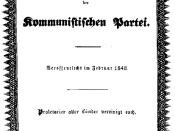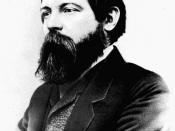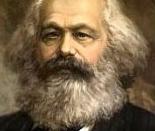Communist Manifesto
Karl Marx, a German philosopher was not only an economist but also a great sociologist. When Marx moved to Paris in 1843 he met Friedrich Engel. There they worked on several books together. Marx and Engel's are best known for their pieces on communism. G.W.F. Hegel's theory presents history as a process in which the world becomes conscious of itself as spirit. Marx took Hegel's theory and furthered it, saying that as man becomes conscious of himself as spirit, the materialistic world causes him to feel increasingly alienated from himself. Escape from this alienation requires a revolution. Together, Engel and Marx worked on the Communist Manifesto. The work spoke the famous words, "The history of all hitherto societies has been the history of class struggles."
The Communist Manifesto has Marx's vision of the history focusing on the development and eventual destruction of the bourgeoisie, which is equivalent to the middle class.
Before the bourgeoisie rose to notoriety, society was organized according to a feudal order run by aristocratic land owners and corporate guilds. With the expansion of the economic markets, a new class arose, the manufacturing class form. This class took control of international and domestic trade. They did this by producing goods more efficiently than the closed guilds. With their growing economic powers, this class began to gain some political power. They destroyed the vestiges of the old feudal society, which sought to restrict their ambition. The French Revolution was the most decisive instance of this form of bourgeois self-determination. Marx thought bourgeoisie control was pervasive that he claimed, "The executive of the modern State is but a committee for managing the coming affairs of the whole bourgeoisie". Marx believes that all of history should be understood in this way as the process in which...



Your right
but the essay should been a 9th grader means that even a student at 9th grade can write this essay!!, but it's still good!!
8 out of 8 people found this comment useful.